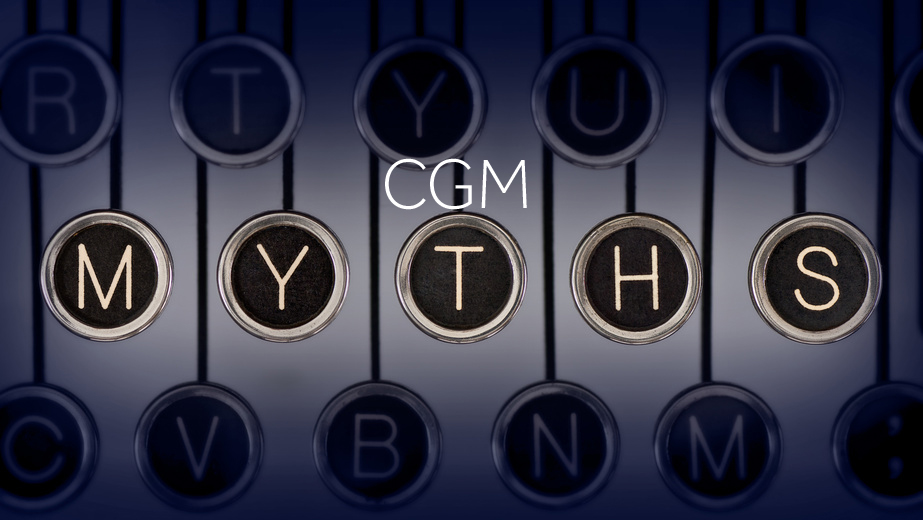Five myths of CGM

When first thinking about insulin pump therapy or continuous glucose monitoring (CGM), did you have questions or thoughts of what it might be like and how it would work? Maybe you were concerned about what taking the next step would be like?
Or, you may have used CGM in the past, but with so many advancements over the last couple of years there may be other things you could learn. Today, we address a few misconceptions or myths people associate with CGM, and tell you the real answers.
Myth 1: If I go on CGM, it will replace my fingerstick tests.
Reality: While this is the goal for the therapy in the future, today’s CGM devices do not completely replace fingerstick testing. Since sensor readings are taken from your interstitial fluid and not your blood, you still need to test using a BG meter. This is required to calibrate the sensor throughout the day, to make sure the glucose sensor maintains accuracy over time and always when deciding whether or not to make a treatment decision.
Myth 2: CGM devices are not accurate.
Reality: An oldie but goodie. It is important to note that sensor glucose readings are taken from your interstitial fluid (fluid surrounding the cells in your tissue), whereas fingerstick tests are taken directly from your blood. Because the readings are from two different places, there is a natural lag between glucose levels in the interstitial fluid and glucose levels in the blood. Therefore, it’s normal, and should be expected, for your sensor glucose readings and BG readings to be different but for the most part they should be close. Learn more here.
One thing to keep in mind is that when you check your BG other CGMs automatically change the sensor number to match the BG number. This does not necessarily mean it’s more accurate. Often, it doesn’t make sense to just match the BG since the sensor is measuring glucose from interstitial fluid, a different part of the tissue (not the blood). Our sensors take into account multiple factors in the calibration to provide an accurate glucose sensor reading.
Myth 3: CGM is only about knowing your glucose levels at all times.
Reality: Actually, CGM is a lot more than just readings every five minutes. Yes, sensor glucose readings and threshold alerts let you know where you are at in any given moment or where you’ve been – but more advanced CGM systems can mimic some of the functions of a healthy pancreas by stopping insulin when your sensor glucose level reaches or goes below a preset limit. With the introduction of SmartGuard™ technology, exclusive to Medtronic devices, CGM can now do more than just alert you, it takes action to reduce lows* without increasing A1c levels**1. Learn more here.
Myth 4: Wearing CGM will give me information overload.
Reality: With alerts, graphs, and sensor glucose readings occurring every 5 minutes, it may seem like your CGM devices give a lot of information at first, but with the right product training and an explanation of how to use the information, you will have the tools to help you take control of your glucose management. To help you ease into it, you may want to turn off the alerts for the first few weeks. We recommend working closely with your diabetes team to make sure you have the right settings in place and over time you will gain the expertise to use the more advanced features like predictive alerts or rate of change. Take it at your own pace so you can get the most out of the therapy and ultimately help fine tune your glucose management.
Myth 5: Data from CGM can only be viewed on my pump screen or monitor.
Reality: Your CGM data can be viewed by your healthcare provider and care network in a variety of ways. One option is therapy management software, which for Medtronic is called CareLinkTM software. CareLink software creates reports that can help you and your doctor discover trends and patterns, so that you may adjust your personal treatment plan.
In addition to reports, now others can see how you’re doing right on their phone with MiniMedTM Connect. MiniMedTM Connect makes it easy to view your pump and CGM sensor glucose details by linking your MiniMedTM system to an app on your iPhone® or iPod touch®. MiniMed Connect can also share your information online with those closest to you, and send alerts automatically by text message. They’ll know how you’re doing – anywhere, anytime. Learn more here.
Did we answer your questions? Ready to get started on CGM? Click here to learn more about the MiniMedTM 530G system or call us at 800-646-4633 for a free insurance check.
References:
* Measured as sensor glucose values.
** Based upon limited sample size and duration of ASPIRE In-Home study
1Bergenstal RM, Klonoff DC, Garg SK, et al. Threshold-based insulin-pump interruption for reduction of hypoglycemia. N Engl J Med. 2013;369(3):224–232.


